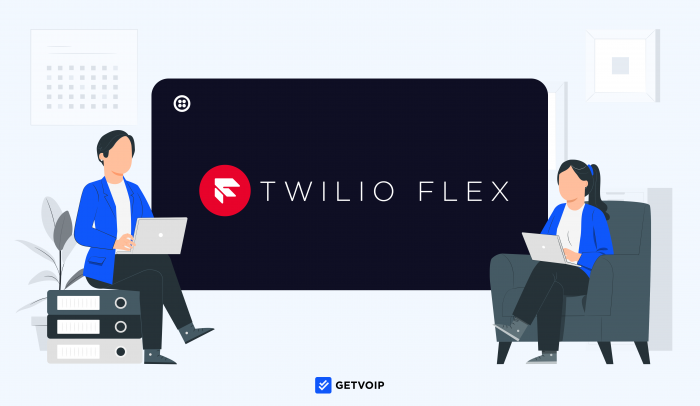Twilio Flex is one of today’s most robust contact center solutions–unifying communication channels, advanced routing, an extensive user interface, and more.
This article will take a close look at Flex, outlining its features, pricing, and benefits.
Jump to ↓
- What is Twilio Flex?
- Twilio Flex Pricing and Plans
- Twilio Flex Features
- Benefits of Twilio Flex
- Who is Twilio Flex Best For?
What is Twilio Flex?
Twilio Flex is a programmable omnichannel contact center unifying customizable communication channels, a dynamic user interface, routing and queueing rules, workflow optimization, and insights.
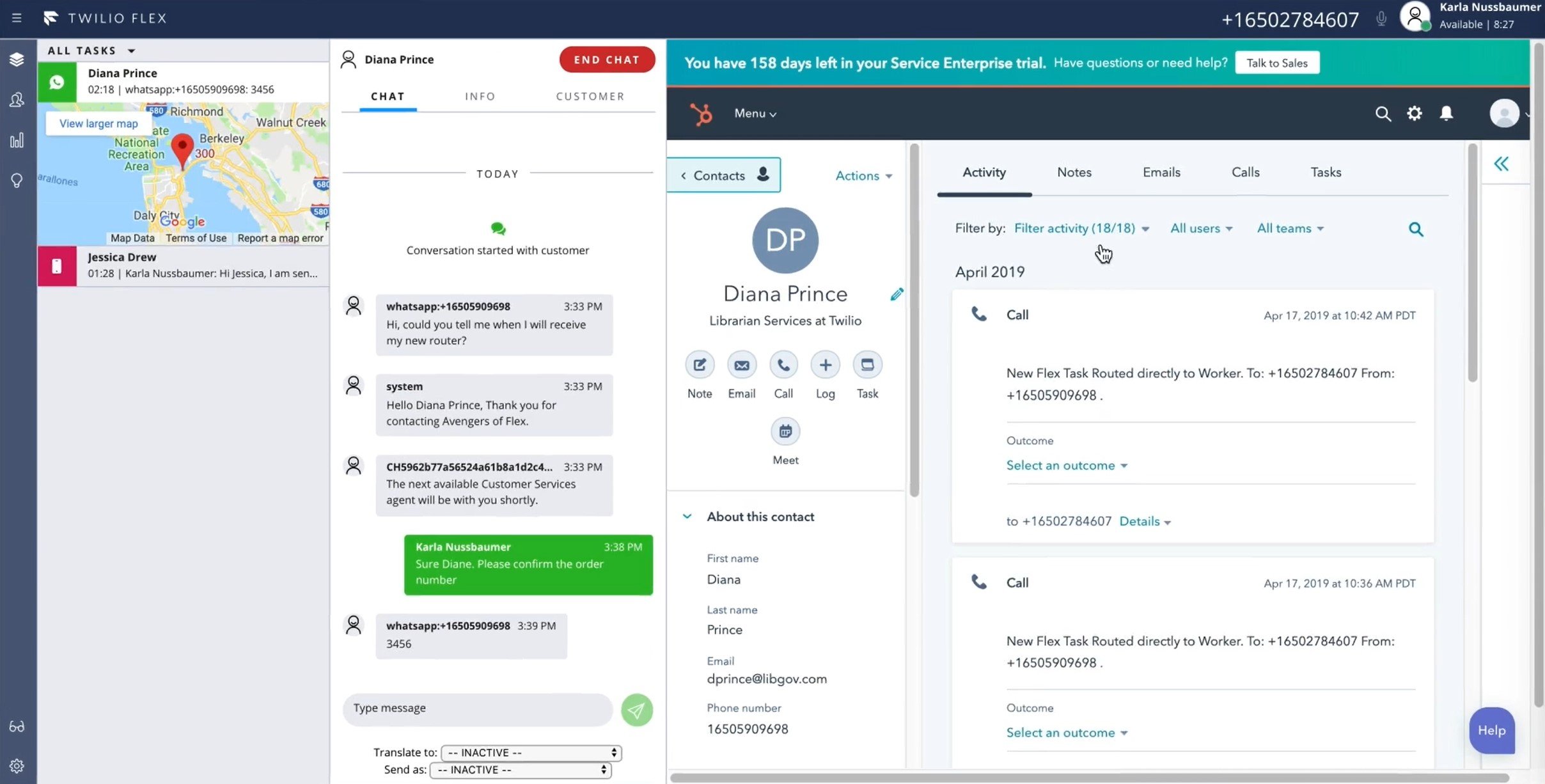
A CCaaS application, Flex leverages Twilio’s massive library of communication channel APIs to connect agents with customers via VoIP phone, email, video, chatbots, embedded web chat, plus transactional and conversational messaging: SMS, WhatsApp, and Facebook Messenger. Agents manage all communication channels in one dashboard, alongside full customer context–CRM-powered contact profiles, database information, automated routing and query handling, and customized task management.
Your team’s developers handle most of the customizable automations via APIs and plugins, allowing agents to manage dozens of complex customer queries simultaneously.
Twilio Flex Pricing and Plans
Twilio Flex is charged by the user, with 5000 free user hours and two pricing options: $1 per active user per hour, or $150 monthly per named user.
$1 per active user hour works well for companies with many part-time agents that only work a handful of days per week, or a few hours per day. On the other hand, the $150 monthly per-user rate works well for companies whose agents work full-time.
Twilio Flex Features
Below, we’ve outlined Twilio Flex’s key features and functionality.
Easy Setup
Twilio Flex comes ready to use immediately, with a setup process that takes just a few minutes. Simply name your project, invite agents and developers, and begin serving customers.
The Twilio system automatically configures agent routing, studio flows like chatbots and IVRs, agent communication channel controls, task lists, and reporting. New agents are automatically assigned a Twilio DID number–or you can port in your company’s pre-existing numbers–to begin calling, texting, messaging, video meeting, and emailing.
Omnichannel Single User Interface
Flex’s application interface gives agents a single-pane view of all channels, tasks, customer information and context, and insights.
Agent Task List
When an agent receives a query or task, it appears in the dashboard’s All Tasks list. Each new task, representing a customer contact query, indicates which channel the customer is using: email, web chat, WhatsApp, voice, or SMS.
The task list organizes dozens of multichannel tasks at once, allowing agents to jump between them quickly. No matter which channel a customer uses, the agent can respond via that same channel. Agents can accept or reject tasks with one click, and can share or transfer tasks to teammates.
When an agent opens a query, all parts of the dashboard adjust to provide the optimal customer-service context: the conversation history with text box, a full customer profile with contact information, customer journey and notes, plus other relevant data pulled from integrated sources like a database or CRM system.
Multichannel Task Handling
Flex unifies Twilio’s suite of communication APIs:
- Programmable voice API: Agents can receive and make VoIP calls around the world using the programmable voice API. Twilio’s Super Network leverages thousands of phone carriers and organizations, choosing the most efficient route for audio data transfer–for local or international calls.
- DID Phone number: Each user receives a Twilio direct inward dial number–including local, toll-free, vanity numbers, and even shortcodes. Twilio also allows you to port in agents’ pre-existing numbers.
- Conversations API: Send 1:1 or group-chat messages on SMS, MMS, WhatsApp, Facebook Messenger, or your own embedded web chat widget. These individualized messages personalize support and recommendations, for improved customer engagement.
- Programmable Messaging: Send and receive automated, transactional messages via SMS, MMS, and WhatsApp, for use cases including alerts, notifications, password updates, user authentication, and delivery updates.
- SendGrid Email API: Twilio SendGrid allows you to send and receive automated and conversational emails, utilizing Twilio’s routing network that helps avoid landing in the spam folder.
- Programmable Video: Utilize built-in HD video meetings accessible on all major browsers and devices–including JS, iOS, and Android. Meetings support collaboration features like whiteboards, chat, polls, and background noise cancellation.
- Chatbots: Use Twilio’s Studio flow builder tool to design self-service chatbots, on SMS or web chat embedded into your website and mobile app. Customers can click on your chat widget, or send an SMS, and receive a programmed response that can handle basic functions like routing, password changes, delivery updates, and more.

Routing, Voicemail, Call Control, and Monitoring Features
Popular Twilio Flex Contact Center Features:
- Task routing: Route inbound tasks to particular agents and queues based on task attributes and agent skills
- Queueing: Organize agents into task queues–such as customer support, sales, and technical support. Agents can view the tasks in their individual or shared queue and prioritize, while customers wait on hold or receive a callback later.
- Twilio Studio flow builder: Twilio Studio is a drag-and-drop flow builder you can use to design automated routing menus–combining various channels, users, messages, and app functions. Build self-service IVR systems, chatbot conversation flows, and more.
- Call recording: Add automated or on-demand call recording
- Call monitoring: Supervisors can quietly listen in on calls for evaluative purposes, offer private agent guidance, or join the live call
- Voicemail: Encode a virtual voicemail system, with transcription, for agents and queues
- Call controls: Live-agent call controls include mute, hold, transfer, and park. Agents can switch channels mid-call, transferring from voice to message or video.
Programmability
Although Twilio Flex comes ready to use, you can customize and program nearly every part of your contact center platform–channels, the user interface, task workflows, routing, and more.
Twilio Flex utilizes a plugin mechanism that enables your developers to mix and match APIs from across the web and Twilio’s documentation, integrating them with your contact center’s code for full control over the agent experience and application capabilities.
Flex documentation and SDKs include content strings–a massive list of commands and sample code that guides agents through the process of implementing and modifying contact center functionality.
User Interface Programmability
Customize the agent’s UI–including dashboard themes and colors, all text, panels and their arrangement, sidebar menu options, the task list display style, and more.

Workflow Programmability
Set automated workflow sequences–including tasks, actions, and functions–based on triggers that occur within Flex. Set a trigger–any action ranging from a caller answer or hangup, task completion or acceptance, inbound message, lead identification–and design an automated action sequence to follow.
Action sequences can weave together functions across Twilio’s APIs: user authentication, automated outbound messages, agent notifications, and more. Further, sequences can include APIs from across the web, with personalized functionality like inserting randomly generated quotes, cat pictures, useless facts, and nearly anything you can imagine.
Routing Programmability
Twilio Flex assigns tasks using TaskRouter API, a skills-based routing engine that handles multichannel queuing, routing, and task assignment for all contacts that reach your app.
Based on actions that occur within Flex–like an inbound or outbound call, received message, IVR menu selection, or chatbot keyword–TaskRouter routes each task to the best-suited agent or queue. TaskRouter qualifies the best match based on attributes like the skills required, the skill level required, language, task priority, and hundreds of other factors you can customize and preset.
Supervisors and administrators can evaluate and set attributes for each user and queue in the system, controlling which types of tasks match with which agents. For any given task, TaskRouter factors in hundreds of attributes–including Twilio’s preset attributes and the ones that you set.
Route multichannel tasks based on various layers of attributes:
- Task requirements and caller attributes: Skill level required, channel used, caller location and VIP status, urgency level, customer sentiment, languages spoken, keywords indicated beforehand, and more
- Agent attributes: Technical ability, skills, skill level, product knowledge, languages spoken, patience level, channel expertise and familiarity, and more
- Rules: Business hours at each location, agent availability, queue length, caller wait time, and more
Dynamic Customer Interactions
When an agent opens a task, the dashboard populates with tools, capabilities, integrations, and data points for optimal customer experience.
In addition to the live chat or call window, the dashboard populates with a detailed customer snapshot, pulling data and context from multiple sources.
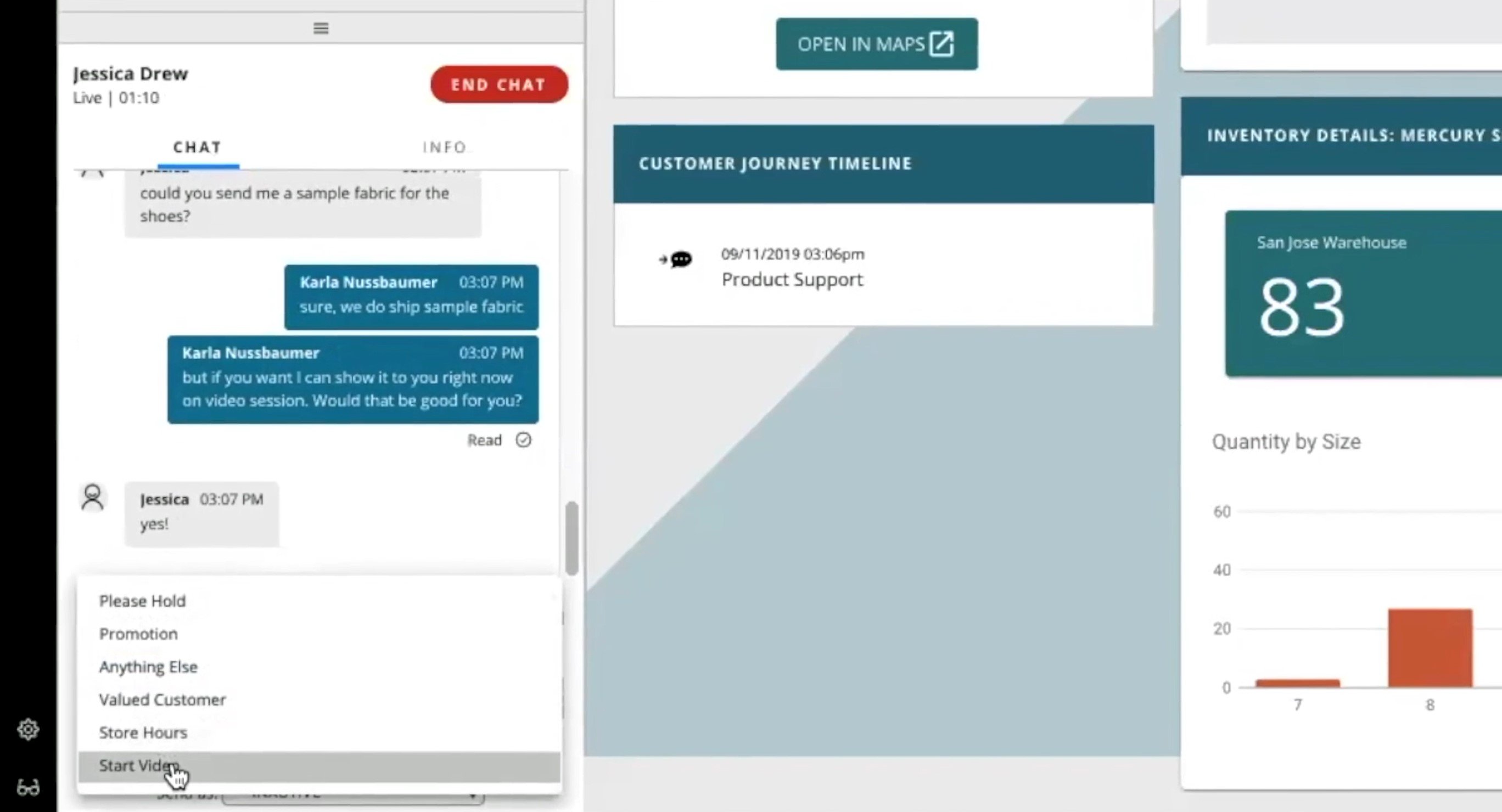
Live Customer-Support Features
- Chatbox actions: While typing a message in the chatbox, agents have dozens of one-click tools at their disposal–canned responses lke store hours and follow-up messages, promotion offerings, and the ability to initiate a video right in the chat window.
- Chat dropdown menus: After an agent types a message in the chatbox, they can modify it with two dropdown menus: translation into dozens of languages, or the option to send the message via any messaging channel
- Contact details: Customer name, email, phone number, company, and location
- Customer journey timeline: A record of the customer’s previous interactions and tasks–including the date and time, channel used, query reason, and the agent who served them
- Real-time customer snapshot: Information about the customer’s current interactions with your app or website–which products, pages, or content they are viewing
- Recent transactions: Using inputs from your CRM system, the dashboard displays the customer’s recent transactions–including date, charge amount and status, and invoice number
- Order details: Drawing from integrations with your database or inventory software, the dashboard displays details about the customer’s order–the product, order date, amount, payment date, and payment method. Agents can view product details and shipping information, and take live action like canceling the order or applying a discount.
Insights and Analytics
Flex Insights is a built-in analytics platform–with reports, dashboards, and KPIs combining data from a variety of sources and inputs throughout your contact center.
Supervisors, administrators, and agents can drill down into all sorts of data–queue statistics, sales success reports, agent performance, and channel usage–sorting insights by user, queue, team, date, and channel. Customize data display in multiple formats, choosing between pie charts, comparative graphs, tables, and colorized statistics.
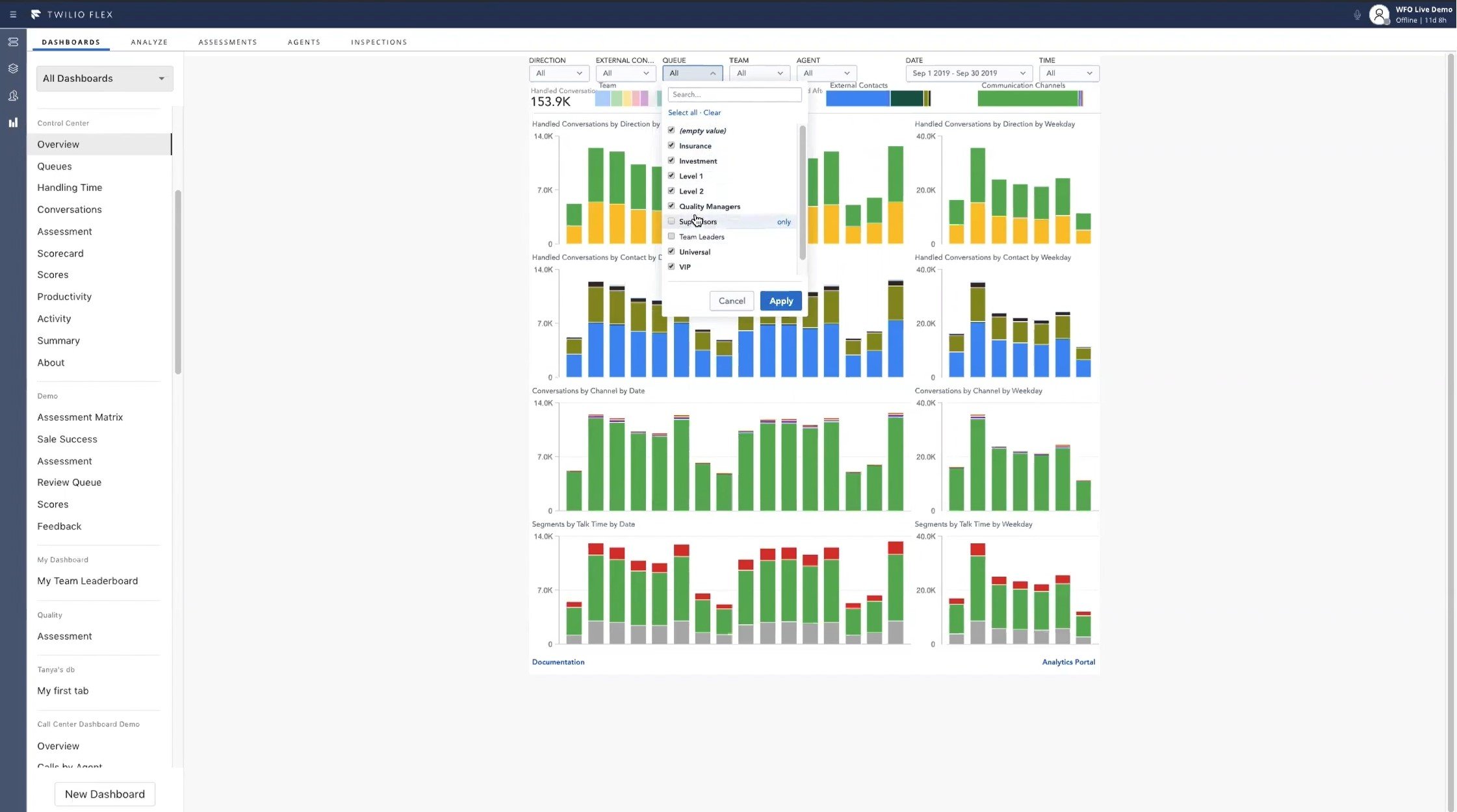
Flex Insights Reports, Data, and Features:
- Queue statistics: Live and historical queue tracking–including answered calls, missed calls, active calls, calls waiting, calls transferred, and more
- Talk-time: Review any conversation–with audio playback displaying agent and customer talk time, moments of silence, and cross-talk
- Call logs: Basic information for all calls, including date, time, agent and customer involved, channels used
- Channel usage: Compare which channels were used, how frequently, and when
- Sale success: The percentage and number of sales calls that led to a successful result
- Agent performance: Customer satisfaction, first-call resolution rate, handle time, and more
- Productivity reports: Statistics regarding each agent’s messages sent, calls made, tasks handled, and more
- Supervisor assessment tools: Supervisors can leave time-logged comments on call log playback audio, can create evaluation sheet templates, and quickly send this feedback to agents
- Custom dashboards and visuals: A drag-and-drop, no-code dashboard builder where you can stack KPIs, data, and multiple view types–tables, bar graphs, line graphs, plot graphs, pie charts. Supervisors can even build their own visuals by stacking metrics side by side and choosing the timeline.
Integrations
Due to Flex’s programmability and code-plugin structure, the cloud contact center integrates with any solution that offers an API. Further, you can leverage multiple applications together at once, syncing data between them to strengthen customer profiles, the user interface, insights and data, and customer journey information.
Twilio Flex pairs especially well with CRM systems like Salesforce and HubSpot, workforce management software like Calabrio and NICE, data management software, and call center add-ons like dialers.
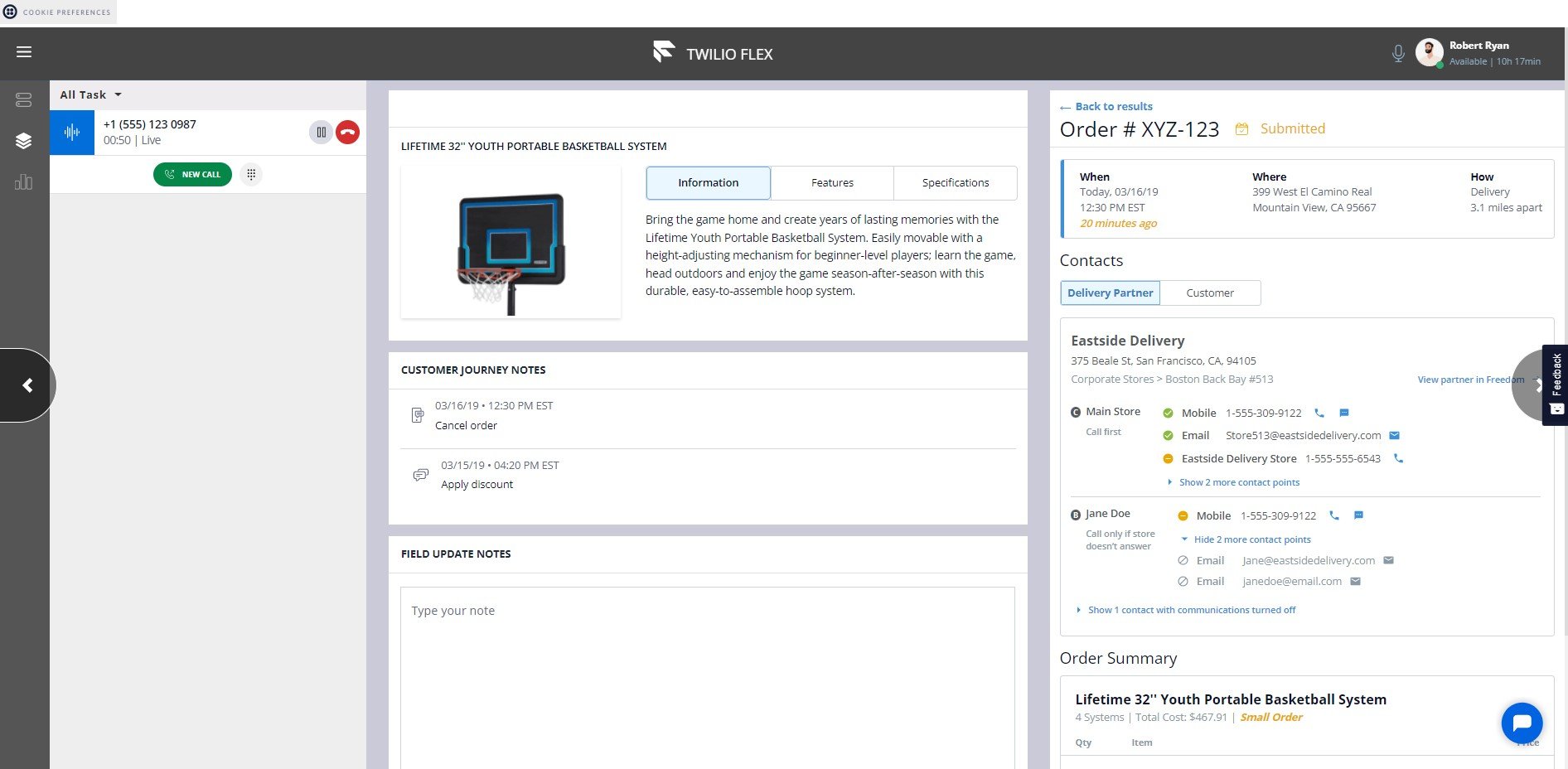
Benefits of Twilio Flex
Compared to other cloud-based CCaaS or UCaaS platforms, Twilio Flex’s benefits include that it is highly programmable, easy to set up, easy for agents to use, and it supports customer-facing agents.
Highly Programmable
Twilio Flex outperforms all competitors–including CCaaS and UCaaS platforms–in the degree of customization that it provides. Its API and plugin-based structure allows developers to customize everything about the contact center: routing, channels, integrated apps, workflows, and user interface.
Easy to Set Up
While Twilio Flex offers robust programmability, the omnichannel contact center comes ready to use with all Twilio channels, preset routing, agent workflows, and analytics. Twilio also offers no-code customization options, such as drag-and-drop custom dashboards and flow-building tools.
Easy to Use
The Flex UI and dashboards make it easy for agents and administrators to use. Agents can view and accept tasks easily, simultaneously handle multiple customer queries across channels, access in-depth customer context on demand, and sort analytics via intuitive dropdown menus.
Supports Customer-Facing Agents
The Flex dashboard gives agents everything they need to provide strong customer support, in a single-pane view, with one-click usage. Agents can switch channels, translate messages, send canned responses, view the customer’s journey, research product information, and apply promotions–all without leaving the Flex app.
Who is Twilio Flex Best For?
Twilio Flex’s CCaaS platform is best for teams that interact with customers across multiple channels in a wide variety of contexts: customer support, sales, and marketing. Since Flex’s core features are its routing engine, communication channels, and informative UI, it best suits teams that deal with a large number of tasks that need to be distributed to multiple teams and agents.
On other hand, Twilio’s other products–including standalone communication APIs–make a great fit for teams looking to add individual communication channels.

